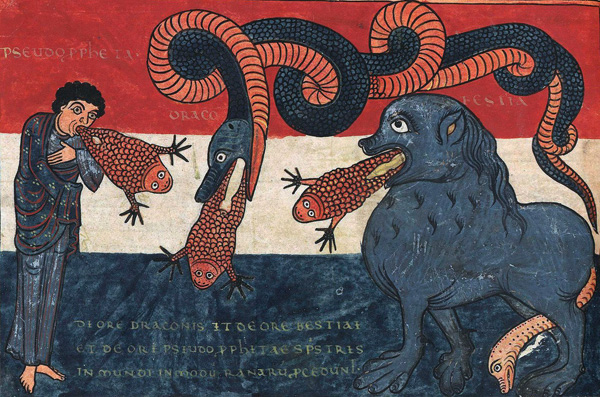The Roman emperor Nero was not well-liked, but he was greatly feared. He was, after all, the original Antichrist, as the numbers associated with the letters of his name in Greek add up to 666. Even after his death, it was widely believed that he would somehow return.
So weird legends grew up around his mad rule. One of the strangest did not appear for over a thousand years. It surfaced in the Golden Legend, a medieval compilation of saints lives, miracles and prodigies, in a tale supposedly told by St. Peter about the craziest thing that Nero ever did: he gave birth to a frog. And it’s a story that has a most curious association with the papacy.
The story is that Nero had his mother killed and cut open so that he could see how it had been for him in her womb. But he wanted to know how it felt. “Nero said to them: ‘Make me pregnant with a child and then make me give birth, so that I may know how much pain it cost my mother!‘”
So they made a potion with a live frog in it which Nero drank. Fearing execution, the doctors used all their skills to make it grow, even making him eat food “suitable for the frog“. Finally, it grew so big they made him vomit it up.
Nero, looking at what he had brought forth, shrank from it and wondered why it was such a monster, but the physicians told him that he had produced a deformed fetus because he had not been willing to wait the full term. He said: “Is this what I looked like when I came out from my mother’s womb?”
“Yes!” they answered. So he commanded that the fetus be fed and kept in a domed chamber with stones in it.
In one version, the poor frog eventually escapes into the Tiber. But here’s where it gets interesting: The palace where the frog was hidden was supposedly called the “Lateran” after it: “lateo, to hide, and rana, a frog.” Hence “the palace of the hidden frog.”
Historians, however, say the area belonged to a prominent Roman family, the Plautii Laterani. After one of them who had risen to the consulship was accused by Nero of conspiracy and executed, the emperor took their lands, including the family palace.
Later, the Emperor Constantine, who legalized Christianity, gave the Lateran Palace to the bishop of Rome. For a thousand years, until the papacy left Rome for southern France in the 1300’s, the Lateran Palace was the seat of the Pope. When the papacy finally returned, the place was run down, so the papal court moved uphill to the Vatican where they have remained ever since, while the palace was eventually made into a museum.
So what does this mean, if anything? It is curious, but frogs are only mentioned twice in the Bible — as one of the plagues in Exodus and also in the Apocalypse of John:
And I saw three unclean spirits like frogs come out of the mouth of the dragon, and out of the mouth of the beast, and out of the mouth of the false prophet.
For they are the spirits of devils, working miracles, which go forth unto the kings of the earth and of the whole world, to gather them to the battle of that great day of God Almighty. [Rev. 16:13-14
So frogs are symbols of unclean spirits, that is, demons, and are closely associated with the False Prophet, a figure often identified with the Roman Pontiff, especially by Protestants, just as the Beast was identified with Nero.
Could the association of frog and pope be much older than generally believed? Could it be that even as far back as Constantine, the bishop of Rome was suspected of being maybe not of God, but the Devil? Or is God trying to tell us something?

